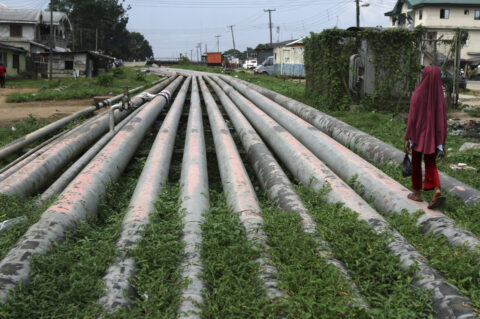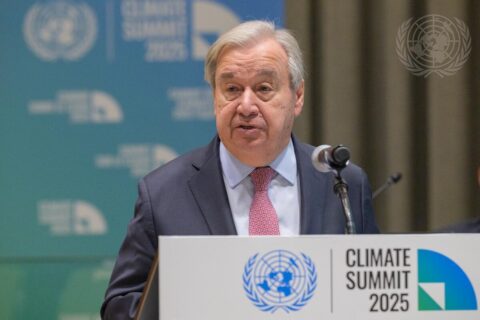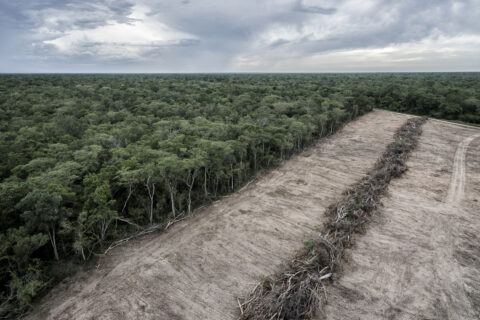Russia’s new climate plan justifies the use of natural gas as a “transition fuel” by referencing the controversial loophole that it pushed to have included in the COP28 pledge on shifting away from fossil fuels.
In a landmark agreement at the Dubai climate summit two years, governments agreed to call on each other to work on “transitioning away from fossil fuels in energy systems” as one of eight global efforts to fight climate change.
The hard-won agreement followed years of campaigning by climate activists and pro-climate action governments, and was hailed as “the beginning of the end” for the fossil fuel era by UN climate chief Simon Stiell.
But in a concession to some countries that were led by Russia – the world’s second-biggest gas producer, the COP28 agreement included a paragraph recognising that “transitional fuels can play a role in facilitating the energy transition while ensuring energy security”.
After it was agreed, Antigua and Barbuda negotiator Diann Black-Layne called it a “dangerous loophole” because natural gas is a fossil fuel “we need to transition away from”.
This year, all the signatories of the 2015 Paris Agreement are due to submit their emissions reduction targets up to 2035, and must say how their targets have “been informed by” the COP28 agreement.
Gas as “transition fuel”
Russia’s new climate plan says it is compatible with paragraph 28 of the COP28 agreement – which includes the language on transitioning away from fossil fuels – because Russia “continues to contribute to the global effort to reduce greenhouse gas emissions through national efforts to the greatest possible extent”.
It adds that the transition should be “based on independence and freedom of choice, the technological neutrality in designing the composition of energy mix and implementing climate policies in the energy sector”.
It then cites the COP28 language around transitional fuels to say Russia “uses natural gas as a transition fuel on the way towards a low-carbon economy” and gas “is the most environmentally friendly type of fuel among the types of conventional heat generation”.
While burning gas for power releases less emissions directly than burning coal, whether or not it emits less overall depends mostly on how much gas leaks as it is transported from where it is produced to where it is consumed, energy experts say.
Andreas Sieber, associate director of policy and campaigns at renewable energy advocacy group 350.org, said Russia was “wilfully misreading the global stocktake”.
“Rebranding methane-heavy, flare-ridden gas as a ‘transition fuel’ is spin, not science [which] props up a regime whose political economy runs on petro-rents and aggression,” Sieber told Climate Home News, adding “any credible transition runs on renewables and efficiency, not on Russia’s gas”.
Russian climate envoy Ruslan Edelgeriev told a UN climate summit last week the country’s commitment to reaching net zero by 2060 was firm and it “has moved from strategy to practical implementation”.
Russia is not the only government to play down the COP28 language on transitioning away from fossil fuels. Shortly after COP28, the Saudi energy minister said the agreement in Dubai was just an “a la carte menu” from which governments could choose.
And several African countries including Nigeria have set out plans to boost the use of fossil gas as a “transition fuel” in their updated Nationally Determined Contributions (NDCs).
“Unambitious” target
Russia’s plan aims to reduce emissions to 33%-35% below their 1990 levels by 2035. This adds to existing targets to cut emissions by 30% on 1990 levels by 2030 and reach net zero – when the country emits no more than it absorbs – by 2060.
Russia’s emissions dropped by a quarter after the Soviet Union collapsed in the 1990s, making percentage reductions on 1990 levels much more achievable. US President Donald Trump noted this in a recent UN speech, saying “Russia was given an old standard that was easy to meet – 1990 standard”.
Climate Action Tracker (CAT), a nonprofit which assesses governments’ climate plans and policies, said Russia’s new 2035 target “does not increase ambition beyond business as usual” because Russia’s current policies already put it on course to cut emissions 35% by 2035.
CAT said that is at odds with a Paris Agreement principle that targets should reflect the “highest possible ambition”. “Russia’s 2035 target not only fails to reflect highest ambition, but does not increase ambition at all”, CAT said in an analysis on its website.
Russia says the target is in line with the Paris Agreement’s goal to hold a temperature increase to 2C and pursue efforts to limit it to 1.5C. CAT said, however, that it was only compatible with warming of 4C or more.
Under its climate plan, Russia says it will cut overall emissions through gas, nuclear, hydropower, renewables, carbon capture and storage and hydrogen. It will also aim to reduce the emissions which come from producing coal and oil, by capturing and selling gas rather than burning it as a waste product and by detecting and fixing pipeline leaks.
CAT also accused Russia of taking too much credit in its carbon accounting for the emissions absorbed by its huge forests. UN guidelines say countries should only take credit for forests which they actively manage, giving governments discretion to decide which land falls into this category.
Russia claims it manages nearly two-thirds of its vast forests, a percentage CAT said was “inflated”. Other heavily forested nations such as Guyana – which claims to be “carbon negative” – have been criticised by climate campaigners for similarly large assumptions about how much forest they manage.
The post Russia justifies fossil gas use by citing contentious COP28 loophole appeared first on Climate Home News.
Russia justifies fossil gas use by citing contentious COP28 loophole
Climate Change
Can COP30 mark a turning point for climate adaptation?
Cristina Rumbaitis del Rio is a senior advisor on adaptation and resilience and Pan Ei Ei Phyoe is a climate adaptation and resilience consultant with the United Nations Foundation.
COP 30 compels the world to make a decision. Already 3.6 billion people are highly vulnerable to rapidly worsening climate impacts such as droughts, floods, and heat stress. Meanwhile, Glasgow-era climate finance commitments are expiring, and elements of the Global Goal on Adaptation (GGA) are yet to be finalized.
This November provides the opportunity to elevate the issue of adaptation and resilience – and for countries to demonstrate they grasp the urgency and are prepared to act.
Success at COP30 will hinge on how three key questions are answered:
- Will countries agree on a new adaptation finance target backed with real commitments?
- Will countries finalize architecture to track progress toward the Global Goal on Adaptation and implement the UAE Targets for Global Climate Resilience?
- Will adaptation receive elevated political attention at COP30?
A new adaptation finance target backed with real commitments
Belém will test whether negotiators can agree on a new adaptation finance goal that is anchored in clear targets, timelines, and accountability. The Glasgow Climate Pact’s goal to double adaptation finance is set to reach its deadline at the end of this year and countries are facing the question of what, if anything, comes next.
The form of the finance goal also matters: will it be a provision-based target ensuring measurable public contributions, or a mobilization target dependent on less transparent private leverage?
After two consecutive years of falling short, all eyes will be on whether the Adaptation Fund can finally meet its mobilization target and secure a multi-year replenishment to deliver predictable support.
Multilateral development banks (MDBs) are under pressure to demonstrate how to integrate adaptation into country-platform approaches including aligning finance for accelerated country-driven action and providing fast-start financing for implementation of National Adaptation Plans. NAPs have been completed by 67 developing countries and are underway in another 77 countries.
Climate adaptation can’t be just for the rich, COP30 president says
Vulnerable countries currently need an estimated $215 billion-$387 billion annually to adapt to climate change, far exceeding available funding. And developed countries face growing expectations to renew or grow their bilateral commitments beyond Glasgow-era pledges that are expiring this year or next.
Without tangible new finance commitments, the ambition of the Global Goal on Adaptation risks remaining rhetorical.
System to track progress on the Global Goal on Adaptation
The GGA still has no mechanism to measure progress, despite being established under the Paris Agreement in 2015, shaped through multiple work programs since 2021, and further expanded by the UAE Framework for Global Climate Resilience of COP28 which set 11 targets and launched the UAE-Belém Work Programme.
Agreeing on a robust, streamlined indicator set that is both scientifically sound and usable by countries with differing capacities will be one of the hardest tasks at COP 30. These outcomes will be a test of whether we can move from measuring resilience to building it.
Foreign aid cuts put adaptation finance pledge at risk, NGOs warn
Negotiators must settle the inclusion of equitable means-of-implementation indicators covering finance, technology, and capacity building. Finally, they must decide what comes next under the UN Framework Convention on Climate Change to ensure the UAE targets are acted upon within the next two to five years.
Those targets include seven that set resilience priorities for water and sanitation, food and agriculture, health, ecosystems, infrastructure, livelihoods and cultural heritage.
Adaptation needs greater political attention at COP30
Last week, COP30 President Corrêa do Lago released the first-ever COP presidency letter focused on elevating adaptation, calling for solutions that will make Belém the “COP of adaptation implementation”. His task now is to embed that principle across every strand of COP30’s delivery architecture.
One test lies in how realistically adaptation is integrated into the Baku-to-Belém Roadmap to $1.3 trillion to be released by the presidency. The implementation of the COP 30 Action Agenda, which provides a blueprint for collective climate action and solutions, could become the bridge between political vision and practical delivery on adaptation.
Questions remain on whether Brazil’s leadership on adaptation thus far will position adaptation as a political priority that will be reflected in leaders’ statements at the opening of COP30. The inaugural High-level Dialogue on Adaptation – hosted by the outgoing COP President Azerbaijan and Brazil – is another opportunity where countries can reaffirm and institutionalize adaptation as a permanent pillar of climate action.
In the role as the host and president of COP30, Brazil has repeatedly stressed the importance of matching adaptation with actual resources and accountability, highlighting adaptation as one of the five guiding stars of the Paris Agreement alongside mitigation, finance, technology, and capacity building.
With the right outcomes in Belém on finance targets, measurement systems, and political commitments, COP30 could be remembered as the moment adaptation financing and implementation finally matched the scale of the challenge.
The post Can COP30 mark a turning point for climate adaptation? appeared first on Climate Home News.
Climate Change
Cranberry Farmers Consider Turning Bogs into Wetlands in Massachusetts As Temperatures Rise
The state is helping to transform cranberry bogs to into habitats that broaden conservation and climate change resilience.
What happens when a region no longer has the ideal climate for its star crop?
Cranberry Farmers Consider Turning Bogs into Wetlands in Massachusetts As Temperatures Rise
Climate Change
As Lake Powell Recedes, Beavers are Building Back
The decline of the reservoir threatens the water and electricity for 40 million people, but is resurfacing vast canyons and lush riversides that the aquatic rodents engineer into robust habitats for many species.
To hike up this narrow canyon, Eric Balken pushed through dense thickets of green. In the shadow of towering red rock walls, his route along a muddy creekbed was lined with bushes and the subtle hum of life. The canyon echoed the buzzing and chirping of bugs and toads. But not long ago, this exact spot was at the bottom of a reservoir.
-
Climate Change2 years ago
Spanish-language misinformation on renewable energy spreads online, report shows
-
Climate Change3 months ago
Guest post: Why China is still building new coal – and when it might stop
-
Climate Change Videos2 years ago
The toxic gas flares fuelling Nigeria’s climate change – BBC News
-

 Greenhouse Gases1 year ago
Greenhouse Gases1 year ago嘉宾来稿:满足中国增长的用电需求 光伏加储能“比新建煤电更实惠”
-
Greenhouse Gases3 months ago
Guest post: Why China is still building new coal – and when it might stop
-

 Climate Change1 year ago
Climate Change1 year ago嘉宾来稿:满足中国增长的用电需求 光伏加储能“比新建煤电更实惠”
-

 Carbon Footprint2 years ago
Carbon Footprint2 years agoUS SEC’s Climate Disclosure Rules Spur Renewed Interest in Carbon Credits
-
Renewable Energy4 months ago
US Grid Strain, Possible Allete Sale








